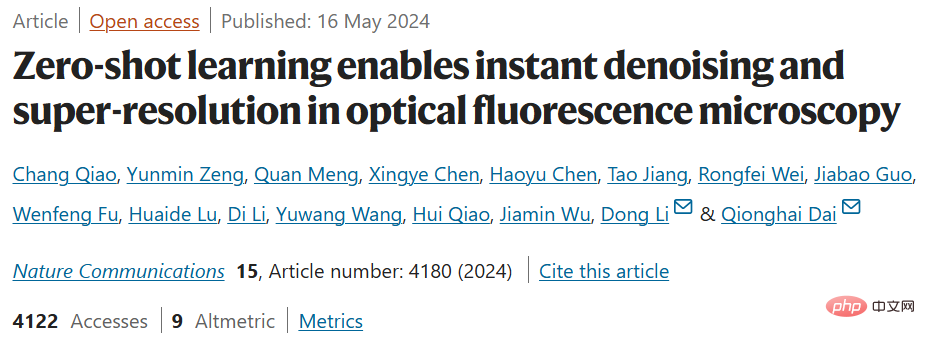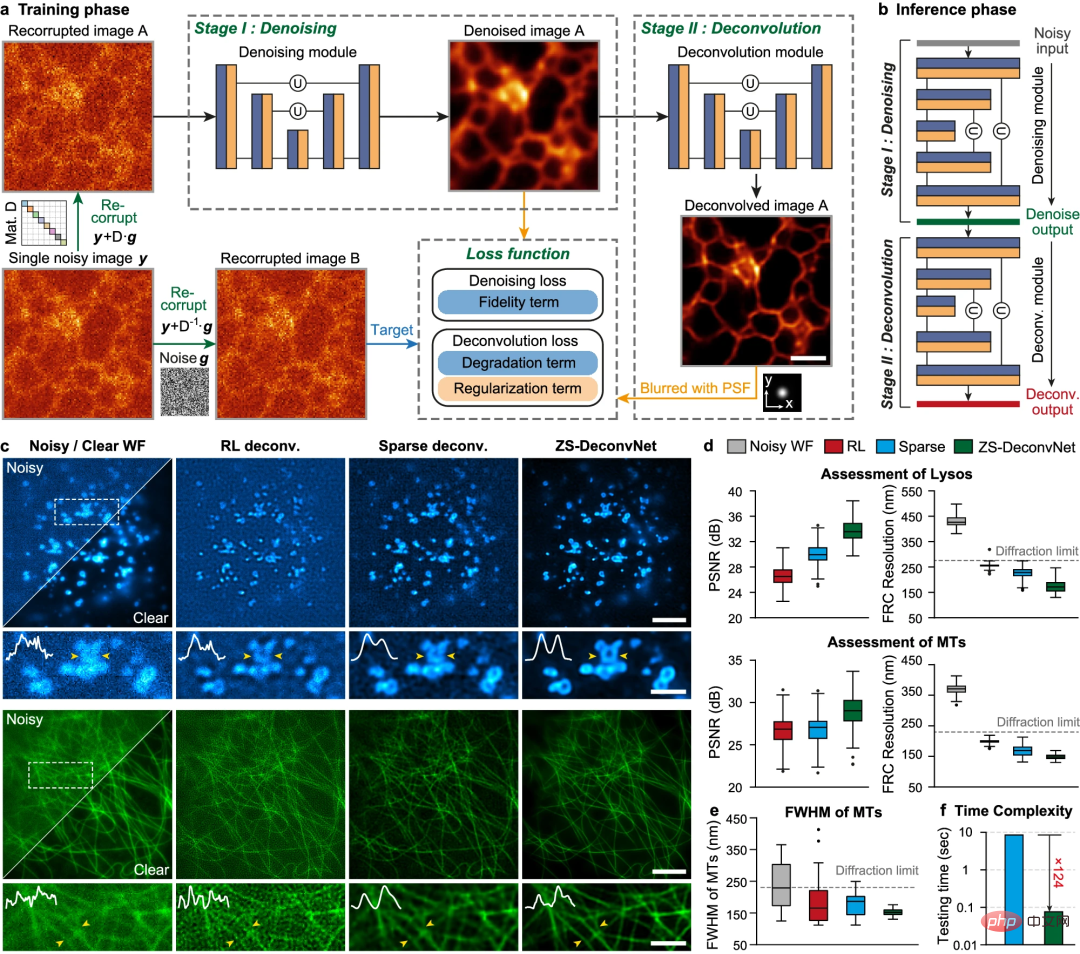

Editor | Radishpi
Computational super-resolution methods, including traditional analysis algorithms and deep learning models, have greatly improved optical microscopy. Among them, supervised deep neural networks have shown excellent performance, but due to the high dynamics of living cells, a large amount of high-quality training data is required, and obtaining these data is very laborious and impractical.
In the latest study, researchers from Tsinghua University and the Chinese Academy of Sciences developed zero-shot deconvolution networks (ZS-DeconvNet) that can instantly increase the resolution of microscope images by more than 1.5 times more than the diffraction limit while fluorescence is 10 times lower than ordinary super-resolution imaging conditions, performed in an unsupervised manner without the need for ground experiments or additional data collection.
The researchers also demonstrated the versatile applicability of ZS-DeconvNet to multiple imaging modes, including total internal reflection fluorescence microscopy, three-dimensional wide-field microscopy, confocal microscopy, two-photon microscopy, and lattice light microscopy. Slice microscopy and multi-modal structured illumination microscopy; it enables multi-color, long-term, super-resolution 2D/3D imaging of multi-cell embryonic organisms from mitotic single cells to mice and Caenorhabditis elegans.
The research is titled "Zero-shot learning enables instant denoising and super-resolution in optical fluorescence microscopy" and was published in "Nature Communications" on May 16, 2024 》.

Optical fluorescence microscopy is crucial for biological research. The advancement of super-resolution technology has improved imaging details, but along with the improvement of spatial resolution comes the trade-off of other imaging parameters. Computational super-resolution methods have become a research hotspot due to their ability to improve image quality online, enhance the capabilities of existing equipment, and expand the scope of applications.
These methods are divided into two categories: deconvolution and other technologies based on analytical models and super-resolution (SR) networks based on deep learning. The former is limited by parameter tuning and poor adaptability to complex imaging environments. The latter can learn complex image transformations through big data, but faces the challenge of difficulty in obtaining and high dependence on the quality of training data. This limits the popularity of deep learning super-resolution technology in daily applications in biological research.
Here, a research team from Tsinghua University and the Chinese Academy of Sciences proposed a zero-shot deconvolution deep neural network framework ZS-DeconvNet, which is capable of unsupervised training of the DLSR network using only a low-resolution and Planar or volumetric image stacks with low signal-to-noise ratio, enabling zero-shot implementation.

Therefore, compared with state-of-the-art DLSR methods, ZS-DeconvNet can adapt to different biological imaging environments, where biological processes are too dynamic and sensitive to light to obtain real SR images , or the image acquisition process is affected by unknown and non-ideal factors.
The researchers said that even when trained on a single low signal-to-noise ratio input image, ZS-DeconvNet can improve resolution beyond the diffraction limit by more than 1.5 times with high fidelity and quantification, and No image-specific parameter adjustments are required.
ZS-DeconvNet is suitable for a variety of imaging modalities, from scanning microscopy to widefield detection microscopy, and has demonstrated its capabilities in a variety of samples and microscopy setups.

Illustration: Generalizing ZS-DeconvNet to multiple imaging modalities. (Source: paper)
Researchers demonstrate that properly trained ZS-DeconvNet can infer high-resolution images on millisecond timescales, enabling light-sensitive processes of multiple organelle interactions, migration, and mitosis High-throughput long-term SR 2D/3D imaging of cytoskeletal and organelle dynamics in C. elegans and subcellular structures and dynamics in developing C. elegans and mouse embryos.

Illustration: Zero-sample denoising and resolution enhancement in multimodal SIM data. (Source: paper)
In addition, in order to make ZS-DeconvNet widely used by the biological research community, the team established a Fiji plug-in toolbox and a tutorial homepage of the ZS-DeconvNet method. Users do not need deep learning knowledge Also easy to use.
Despite its broad applicability and robustness, ZS-DeconvNet users need to be aware of potential phantom generation and its limitations, such as misidentification of low-fluorescence signals, performance degradation when applied to images of different imaging modes, and problems caused by improper PSF matching , and the resolution improvement under unsupervised learning is not as obvious as supervised learning.
In the future, by combining more advanced network architectures, expanding to other optical super-resolution technologies, adopting domain adaptation or generalization technologies, and processing spatially varying PSFs, the functions and application scope of ZS-DeconvNet will be further expanded. .
Paper link:https://www.nature.com/articles/s41467-024-48575-9
The above is the detailed content of 1.5 times beyond the diffraction limit, imaging conditions are 10 times lower, Tsinghua University and the Chinese Academy of Sciences use AI methods to improve microscope resolution. For more information, please follow other related articles on the PHP Chinese website!
 Advantages of plc control system
Advantages of plc control system
 delete folder in linux
delete folder in linux
 Introduction to article tag attributes
Introduction to article tag attributes
 How to type the inscription on the coin circle?
How to type the inscription on the coin circle?
 What does MLM coin mean? How long does it usually take to crash?
What does MLM coin mean? How long does it usually take to crash?
 Common usage of Array.slice
Common usage of Array.slice
 Top ten digital currency exchanges
Top ten digital currency exchanges
 Windows 10 activation key list
Windows 10 activation key list




